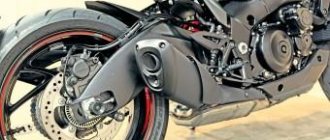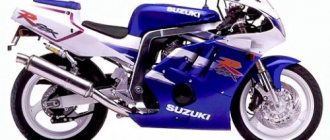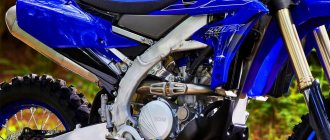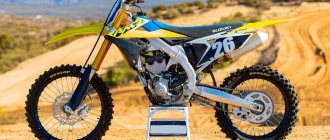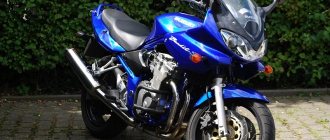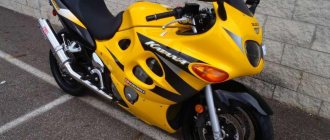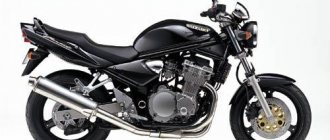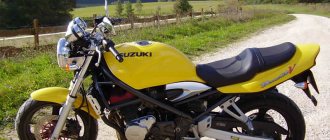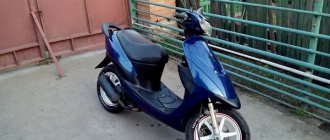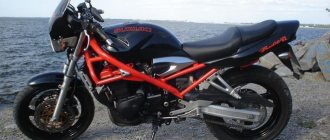| Suzuki GSX-R1100 (1986-1988) | Suzuki GSX-R1100 (1989) | Suzuki GSX-R1100 (1990) |
| Suzuki GSX-R1100 (1991-1992) | Suzuki GSX-R1100 (1993-1998) |
Suzuki GSX-R 1100 sports motorcycle model
first appeared in 1986 based on the Suzuki GSX-R 750 model, but with a more powerful engine. The reason for the creation of the Suzuki GSX-R 1100 was the desire of Suzuki to present to the market a powerful, but at the same time controllable and lightweight sports motorcycle. And at some point they really succeeded - the motorcycle received a lot of positive feedback from experts who noted the power, relatively light weight and decent handling. However, over time, and in particular with the release of the Honda Fireblade, many realized that the handling of the Suzuki GSX-R 1100 is not standard and there may be motorcycles with better handling parameters and lower weight with comparable power. By the way, Suzuki understood this and constantly made changes to the frame and chassis of each new modification of the Suzuki GSX-R 1100, trying to find a compromise. Thus, early versions of the Suzuki GSX-R 1100 are lighter weight, but have a less rigid frame, which makes itself felt under high loads; later versions had a more rigid frame and sharper controls, but suffered from excessive weight. By the way, this is precisely what determines the differing reviews from experts testing different versions of the motorcycle over the years.
In 1989, the Suzuki GSX-R1100 model received major changes. In particular, the steel frame was replaced with aluminum. The engine increased its volume from 1052 to 1127 cm³ and received new Mikuni BST36SS carburetors. Also, models starting from this year are distinguished by black calipers.
In 1990, the model received minor ergonomic and cosmetic changes, as well as a new inverted fork.
Since 1991, the model has changed its appearance, and in particular the design of the headlight and fairing. Aerodynamic characteristics are improved.
The next major changes to the Suzuki GSX-R1100 model occurred in 1993, when the air engine was replaced with a new one - liquid-cooled and slightly reduced in volume to 1074 cm³. Maximum power increased to 155 hp. The frame was updated and became more rigid. The 4-piston calipers were replaced with 6-piston ones. The wheel size has changed - instead of 18′ wheels, the motorcycle received more modern and wider 17′ ones. The fuel tank capacity on all versions except California versions was 21 liters.
Between 1994 and 1998. There were no major model updates. The changes concerned mainly aerodynamic elements and engine settings (to improve torque characteristics).
The Suzuki GSX-R 1100 model was sold until 1998, after which its production was stopped. Suzuki took a break from producing large-capacity sports motorcycles, and only in 2001 introduced the flagship model Suzuki GSX-R 1000, which is still in production today.
Suzuki GSX-R model range:
- Suzuki GSX-R250
- Suzuki GSX-R400
- Suzuki GSX-R600
- Suzuki GSX-R750
- Suzuki GSX-R1000
- Suzuki GSX-R1100
The main competitors of the Suzuki GSX-R 1100 in the class:
- Honda CBR900RR Fireblade
- Kawasaki ZX9R
- Yamaha FZR1000
Brief history of the model
- 1986 - start of production and sales.
Model
: Suzuki GSX-R1100 (Europe, North America, Australia, South Africa).
Factory designation
: GSX-R1100G.
- 1987 - no significant changes.
Model
: Suzuki GSX-R1100 (Europe, North America, Australia, South Africa).
Factory designation
: GSX-R1100H.
- 1988 - no significant changes.
Model
: Suzuki GSX-R1100 (Europe, North America, Australia, South Africa).
Factory designation
: GSX-R1100J.
- 1989 - model changes. Aluminum frame, new larger engine, new carburetors.
Model
: Suzuki GSX-R1100 (Europe, North America, Australia, South Africa).
Factory designation
: GSX-R1100K.
- 1990 - the main change is an inverted fork.
Model
: Suzuki GSX-R1100 (Europe, North America, Australia, South Africa).
Factory designation
: GSX-R1100L.
- 1991 - new look.
Model
: Suzuki GSX-R1100 (Europe, North America, Australia, South Africa).
Factory designation
: GSX-R1100M.
- 1992 - no significant changes.
Model
: Suzuki GSX-R1100 (Europe, North America, Australia, South Africa).
Factory designation
: GSX-R1100N.
- 1993 - model change. New liquid-cooled engine, new frame, 6-piston calipers, wheel size changes to 17′.
Model
: Suzuki GSX-R1100 (Europe, North America).
Factory designation
: GSX-R1100WP.
- 1994 - no significant changes.
Model
: Suzuki GSX-R1100 (Europe, North America).
Factory designation
: GSX-R1100WR.
- 1995 - no significant changes.
Model
: Suzuki GSX-R1100 (Europe, North America).
Factory designation
: GSX-R1100WS.
- 1996 - no significant changes.
Model
: Suzuki GSX-R1100 (Europe, North America).
Factory designation
: GSX-R1100WT.
- 1997 - no significant changes.
Model
: Suzuki GSX-R1100 (Europe, North America).
Factory designation
: GSX-R1100WV.
- 1998 - no significant changes.
Model
: Suzuki GSX-R1100 (Europe, North America).
Factory designation
: GSX-R1100WW.
Specifications
Technical characteristics of Suzuki GSX-R 1100:
| Model | Suzuki GSX-R1100 |
| Motorcycle type | sports |
| Year of issue | 1986-1998 |
| Frame | steel – GSX-R1100 (1986-1988) aluminum – GSX-R1100 (1989-1998) |
| engine's type | 4-cylinder, 4-stroke, in-line |
| Working volume | 1052 cm³ – GSX-R1100 (1986-1988) 1127 cm³ – GSX-R1100 (1989-1992) 1074 cm³ – GSX-R1100 (1993-1998) |
| Bore/Stroke | 76.0 x 58.0 mm – GSX-R1100 (1986-1988) 78.0 x 59.0 mm – GSX-R1100 (1989-1992) 75.5 x 60.0 mm – GSX-R1100 (1993-1998) |
| Compression ratio | 10.0:1 – GSX-R1100 (1986-1992) 11.2:1 – GSX-R1100 (1993-1998) |
| Cooling | air – GSX-R1100 (1986-1992) liquid – GSX-R1100 (1993-1998) |
| Number of valves per cylinder | DOHC, 4 valves per cylinder |
| Fuel supply system | Carburetor, 4x Mikuni BST34SS – GSX-R1100 (1986-1988) Carburetor, 4x Mikuni BST36SS – GSX-R1100 (1989-1998) |
| Ignition type | transistor |
| Maximum power | 130.0 hp (95.6 kW) at 9500 rpm – GSX-R1100 (1986-1988) 145.0 hp (106.6 kW) at 9500 rpm – GSX-R1100 (1989-1992) 155.0 hp (114.0 kW) at 10,000 rpm - GSX-R1100 (1993-1998) |
| Maximum torque | 102.0 Nm (10.3 kg*m) at 8000 rpm – GSX-R1100 (1986-1988) 112.0 Nm (11.3 kg*m) at 7500 rpm – GSX-R1100 (1989-1992) 115.0 Nm (11.6 kg*m) at 9000 rpm – GSX-R1100 (1993-1998) |
| Clutch | Multi-disc in oil bath, hydraulic drive |
| Transmission | 5-speed |
| type of drive | chain |
| Front tire size | 110/80-VR18V – GSX-R1100 (1986-1988) 120/70-ZR17 – GSX-R1100 (1989, 1991) 130/60-ZR17 – GSX-R1100 (1990) |
| Rear tire size | 150/70-VR18V – GSX-R1100 (1986-1988) 180/55-ZR17 – GSX-R1100 (1989, 1991) 160/60-ZR17 – GSX-R1100 (1990) |
| Front brakes | 2 discs, 310 mm, 4-piston calipers – GSX-R1100 (1986-1992) 2 discs, 310 mm, 6-piston calipers – GSX-R1100 (1993-1998) |
| Rear brakes | 1 disc, 220 mm, 2-piston caliper – GSX-R1100 (1986-1992) 1 disc, 240 mm, 2-piston caliper – GSX-R1100 (1993-1998) |
| Front suspension | Telescopic fork (4-stage adjustable preload, 3-stage adjustable rebound), 130 mm travel – GSX-R1100 (1986-1989) Inverted telescopic fork (fully adjustable), 120 mm travel – GSX-R1100 (1990) -1998) |
| Rear suspension | Swingarm with monoshock (fully adjustable preload, 4-step adjustable rebound), travel - 135 mm - GSX-R1100 (1986-1989) Swingarm with monoshock (fully adjustable), travel - 160 mm - GSX-R1100 (1990-1998) ) |
| Motorcycle length | 2115 mm – GSX-R1100 (1986-1990) 2130 mm – GSX-R1100 (1991-1998) |
| Motorcycle width | 745 mm – GSX-R1100 (1986-1990) 755 mm – GSX-R1100 (1991-1998) |
| Motorcycle height | 1215 mm – GSX-R1100 (1986-1988) 1150 mm – GSX-R1100 (1989-1990) 1190 mm – GSX-R1100 (1991-1998) |
| Wheelbase | 1460 mm – GSX-R1100 (1986-1988) 1440 mm – GSX-R1100 (1989-1990) 1485 mm – GSX-R1100 (1991-1998) |
| Seat height | 810 mm – GSX-R1100 (1986-1990) 815 mm – GSX-R1100 (1991-1998) |
| Minimum ground clearance (clearance) | 125 mm – GSX-R1100 (1986-1988) 110 mm – GSX-R1100 (1989-1990) 130 mm – GSX-R1100 (1991-1998) |
| Acceleration 0-100 km/h (0-60 mph) | 3.1 sec[1] |
| Maximum speed | 275 km/h[2] |
| Gas tank capacity | 21.0 L – GSX-R1100 (Australia), other countries 1993+ 19.0 L – GSX-R1100 (other countries, 1986-1992) |
| Motorcycle weight (dry) | 197 kg – GSX-R1100 (1986-1988) 210 kg – GSX-R1100 (1989-1990) 231 kg – GSX-R1100 (1991-1998) |
If you compare the engines of both Katanas
Let's compare the old and the new. The only common element will be the number of cylinders - in both cases it is a bank of four cylinders with a head of 16 valves. This is where the similarities end. The engine was once air-cooled, today it is completely different. The carburetor accumulator was replaced by fuel injection and power increased from 100 to 150 hp. Today it's a 2005 GSX-Ra 1000 drive. The body in it works smoothly and softly.
Unlike its competitors, the Katana does not have a ripper, which is a shame. Was this reserved for a version of R that might come in the future? When and if at all is still unknown.
You'll see in the horsepower and torque graphs that both four-cylinder engines are 40 years apart and also have a performance gap. We can assume that the acceleration results to one hundred are the same: the new model accelerates in 3 seconds, and the old one in 3.6 seconds. The faster the ride gets, the larger the barrier separating the two cars.
Motorcycle decorations. The Katana test included many accessories, such as wheel axle ends, rim decals, or the fuel tank. Another display in the new motorcycle that I didn't like. Readability, like the old Katana, is debatable. The steering gear was unchanged from the GSX-Sa 1000. I would have expected something better on a top-end car.
Acceleration to 200 km/h takes 8.6 and 14.8 seconds respectively! This is, of course, a question of power (150 vs. 100 hp), but above all the torque value (108 Nm Katana AD 2021: 89 Nm Katana AD 1981). In a head-to-head match, the older bike's lower rev range only makes up for the loss.
Reviews
Reviews about Suzuki GSX-R 1100:
Expand Collapse
I refueled, crawled and got used to it about 100 km home... the first sensations were a heavy infection, the brakes were weak, everything was somehow not very good. An hour later - This is what I dreamed of! Indeed, Bes, after 1500 km and changing the tires, we are one whole. In traffic jams, he is excellent, goes to the point from a standstill (just place the points correctly), when spinning up to 8-9 thousand of each “teleport” gear, the front wheels do not come off (I have regular sprockets ) maximally accelerated to 290 (I agree that this is too much; tires are designed up to 270, but curiosity took over). At the moment, about 8000 km have been covered, daily use, rain is also not a hindrance, a huge plus is the mass of the motorcycle on the road, as if on rails, the only minus is at high speeds (it’s a bit slow to stop from 200) on the track, it’s a bit heavy without a lot of experience, (this season has already seen a drop on the track) in general it’s a good unit, but it’s a bit expensive for spare parts and a bit old, all the reinforcements are installed from the factory, the chain is 532 with a timing belt the same song... there is not a lot of spare parts... the engine is noisy... the windshield is preferably a little higher (any sport is adjusted to suit itself, there are enough spinners and spinners), but any little inconveniences will pale in comparison with its dynamic capabilities... not many modern sports can compare with it (unless of course go and not take pictures))). and you don’t need to be afraid of the motorcycle itself and its crazy power, be careful and careful yourself... there aren’t very many rules... experience will come with time and your efforts... (to learn how to swim you need to get into the water) as a result - a gorgeous rotten one for affordable money... Repair and Do it yourself...without difficulties, the manual is available, synchronization is not problematic (no need to disassemble anything), the tank lasts 180-200 km, a living unit will live and delight...Good luck on the roads. (I’m 38, I won’t say that it makes me look younger...it makes me look younger doesn't make you old..)))
When driving aggressively, it consumes at least 11-12 liters.
The device is very strong, the frame is rigid, there is a damper right away, the engine has a fairly even torque and pulls well, there are no complaints about the gearbox. The motorcycle is quite heavy (compared to the new liter sports bikes) and its wheelbase is slightly larger. In general, there is a reserve of power, there is a reserve of stability (even if you accidentally steer into long longitudinal cracks/other holes on the asphalt, everything is ok), and it forgives mistakes for a beginner.
The brakes are excellent, even with ordinary unreinforced hoses and without much skill or experience, you can catch the moment when the front wheel begins to slip and squeal (I couldn’t do a stop by accident, I didn’t try on purpose).
Because of the weight, it’s not particularly convenient to turn around on slopes and in the presence of holes, sometimes you want to lighten it by about 50 kilograms, but this rarely happens
At speed, everything is fine with the controls, you can calmly maneuver in the flow without straining.
The engine is noisy, but they say that “old school jixers are almost Ducati”, so it should be noisy.
It’s unpleasant to drive on a dirt road with large stones, as well as on mud/wet clay with ruts, but it’s possible slowly, there are no problems with traction.
There is a transmission sensor in stock that changes the ignition timing in lower gears and reduces torque, making the motorcycle more “user friendly”.
The history of Katana
History repeats itself: like many years ago, the new Katana is born with the help of designers from Europe, in particular from Italy. The project is headed by Rodolfo Frascoli, who contributed to the creation of such cars as the Moto Morini Corsaro 1200, Triumph Tiger and Vespa GT.
The Katana is based on the GSX-S 1000. This underrated power delivers something very important: the bike's quality-to-price ratio. What other car has a 150-horsepower engine, an excellent frame, good suspension, and all this for 800,000 rubles?
Both Suzuki Katanas have European roots. In both cases, the motorcycle designers were specialists from Europe.
When you place the GSX-Sa 1000 next to the Katana, it will look shorter. The same frame, engine and suspension, dressed in a large front fairing, seasoned with a wide saddle and a special wing, look much more massive. The Katana feels taller, longer and more muscular.
You'll have a similar experience when you sit in the saddle. The wide and comfortable seat sits deep, with a (at first glance) large fuel tank in front of you. Everything about the GSX-S 1000 felt smaller and more compact.
You'll immediately feel that the new saddle is higher than the GSX-S (20mm difference) and the handlebars are wider. The knee angle is smaller, making the bike more comfortable. Standing in front of the Katana, you immediately get the impression that even those taller than 190 cm will feel good on it.
